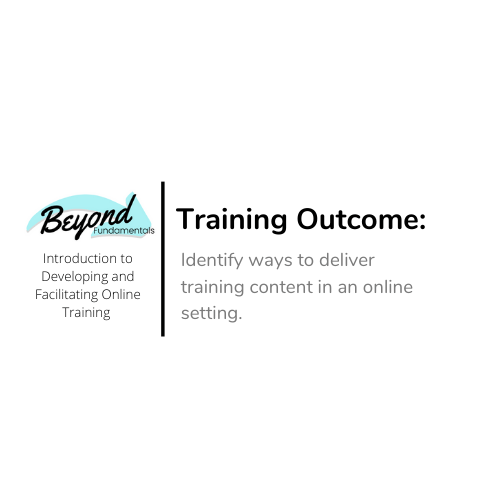Looking for Kentucky’s Early Childhood Professional Development Framework?
Visit the Kentucky Governor’s Office of Early Childhood
or click the link below.
Archives: Lessons
Welcome and Introductions: Putting FET to Work
Course Overview
- This course will take approximately 7 hours to complete (including completion of application activity)
- Upon successful completion of all components 7 hours of how to train other adult hours will be issued
- Audience: Trainers
Course Description
Welcome to Beyond Fundamentals: Putting FET to Work! Putting FET to Work is an 7-hour online learning experience that helps you design a training plan on a topic of your choosing. Upon completion, you will have a new, custom training session that you can begin training on immediately.
This online Seminar includes three, sequential Modules to be completed in order. It is important to get started right away and that you pace yourself. You move on to each subsequent assignment once the prior assignment has been successfully completed and a completion point has been submitted by the Course Facilitator.
The assignments are submitted for feedback, which can include some back and forth between you and the Course Facilitator. Please allow up to 3 business days for your individualized feedback to be provided.
Please note: this is not a course where you sit down at the computer and finish in one, 7-hour session. This course will be stopped and started as needed and necessary to complete and review all components.
Course Facilitator

April Brown
Training Coach – The Lakes Region
If you encounter technical issues with the site, please use the “Contact Us” button at the bottom of this page.
Course Handout
Beyond Fundamentals: Putting FET to Work
Training Outcomes
- Use PACES™ in the development and writing of your training plan.
- Identify the Core Content Competency for your written Training Plan.
- Identify the ‘Level’ of the training that is being developed.
- Provide a balance of training methods that support adult learners throughout your workshop.
Workplace Outcome
Develop ‘leveled’ training plans that incorporate PACES™ and provide a balance of training methods that support the identified Core Content Competency.
Training Methods
In FET these options are referred to as “training methods” in ECE-TRIS these options are referred to as “training modes”. The terms used are different, however the definitions are the same. We will use the term “method”.
A training method is a way of presenting information. In a virtual training session there are several different types of training delivery methods that can be used to disseminate information. Methods are the more specific activities that are used to teach and practice content. Methods can be presented in written content, visual content, learning exercises, or assignments. Kentucky Trainer Credential Regulations require a non-face to face training session must consist of at least 2 different methods.
Deciding which delivery methods to use will be based on the training session and the trainer. A trainer will need to consider:
- what is the most beneficial for the training session Workplace and Training Outcomes,
- what abilities and limitations there are with the Learning Management System (LMS) used, and
- personal preferences.
Using different methods in learning will break up presentation of content. Just as you should not spend an entire face to face training session lecturing, you should not want to use just one method for delivering content in a virtual session.
Lesson 2: Using Polling and Assessment Copy
Why is Polling and Assessment important in training?
How you interact with your audience during your presentation matters. It has, in fact, become a must-have ability in every public speaker’s arsenal. Your participants expect interaction and engagement. They want to participate, not merely observe. One of the most successful ways to do that is live polling. You basically ask your audience a question and they will answer. As simple as that. Taken from: https://blog.sli.do/5-types-of-polls-to-open-your-presentations-with-15-examples/
Engagement is important because it keeps your participants interested and lively. It keeps them in a learning mode, wanting to do more.
Assessment is an important part of training, as well, as it helps the trainer to see whether or not the learning objectives have been met. Assessment helps trainers ask questions such as: “Are we training what we think we are training?” “Are participants learning what they are supposed to be learning?” or “Is there a better way of training the content?
Assessment also helps:
- Provide diagnostic feedback
- Educators set standards
- Evaluate progress
- Relate to a student’s progress
- Motivate performance
Not only does assessment and polling keep the participant engaged, but it can also help on the effectiveness of the course, where learning gaps may exist, and how the participant is progressing. There are two types of assessments. These are Formative and Summative.
Lesson 1: Defining Polling and Assessment Copy
What is Polling? Polling is the sampling or collection of opinions on a subject, taken from either a selected or a random group of persons, as for the purpose of analysis. There are several examples of polling which include: opinion, survey, and questionnaire, Create videos for both)
What is Assessment: “In education, the term assessment refers to the wide variety of methods or tools that [trainers] use to evaluate, measure, and document the academic readiness, learning progress, skill acquisition, or educational needs of
.”From: The Glossary of Education Reform (Create video)
Polling and Assessment: Introduction Copy
Have you ever wondered how to keep participants engaged during a training session. What can trainers do to keep the learning active and fun? Have you tried engaging your audience using polling and assessment? In this online course trainers will learn the importance of polling and assessment, and will get a brief introduction to several types of polling and assessment tools that can be used in training sessions.
Lesson 1: Defining Polling and Assessment
Lesson 2: Using Polling and Assessment
Topic 1: The importance of Polling and Assessment in Training
Topic 2: Formative vs. Summative Assessment
Topic 3: Polling and Assessment Tools
About me
Sorry. You must be logged in to view this form.
Ride Share Savings Calculator
Uber and Lyft
Partner with Waze Carpool
Learning Objective: Identify Ways to Partner with Waze Carpool
Waze Carpool
Learning Objective: Use Waze Carpool
While Ride Sharing isn’t new, Ride Share apps are a new way to share rides and the costs of commuting. Waze Carpool is an app that lets you drive or ride with people already going your way. Drivers and riders with similar commutes to work or school can team up and ride together through the app. Unlike taxi apps like Uber or Lyft, Waze Carpool does not pay drivers or charge a commission on rides.
Assist with Ride Share Planning
Learning Objective: Locate tools to assist participants with Ride Share Planning
Ride Share Frequently Asked Questions
Learning Objective: Explain Ride Share Frequently Asked Questions
Create Ride Share Agreements
What is a Ride Share?
Lesson 2: Using Polling and Assessment
Why is Polling and Assessment important in training?
How you interact with your audience during your presentation matters. It has, in fact, become a must-have ability in every public speaker’s arsenal. Your participants expect interaction and engagement. They want to participate, not merely observe. One of the most successful ways to do that is live polling. You basically ask your audience a question and they will answer. As simple as that.
Engagement is important because it keeps your participants interested and lively. It keeps them in a learning mode, wanting to do more.
Assessment is an important part of the training, as well, as it helps the trainer to see whether or not the learning objectives have been met. An assessment helps trainers ask questions such as: “Are we training what we think we are training?” “Are participants learning what they are supposed to be learning?” or “Is there a better way of training the content?”
The assessment also helps:
- Provide diagnostic feedback
- Educators set standards
- Evaluate progress
- Relate to a student’s progress
- Motivate performance
Not only does assessment and polling keep the participant engaged, but it can also help on the effectiveness of the course, where learning gaps may exist, and how the participant is progressing. There are two types of assessments. These are Formative and Summative.
Taken from: https://blog.sli.do/5-types-of-polls-to-open-your-presentations-with-15-examples/
Lesson 1: Defining Polling and Assessment
–From: The Glossary of Education Reform
Polling and Assessment: Introduction
Have you ever wondered how to keep participants engaged during a training session?
What can trainers do to keep the learning active and fun?
Have you tried engaging your audience using polling and assessment?
Maybe you can relate to one of the outtakes below – either as a presenter or an attendee 🙂

